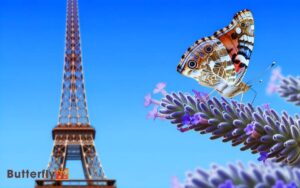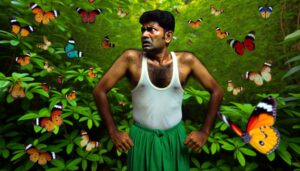Identifying Predators of Butterflies: A Guide for Gardeners
Butterflies are preyed upon by a variety of predators across multiple stages of their life cycle, including birds, spiders, ants, and wasps. Birds such as flycatchers and warblers utilize keen eyesight to hunt, while spiders employ sophisticated web traps.
Ants demonstrate cooperative hunting tactics, targeting immobile larvae. Wasps include both parasitoid and predatory types, greatly affecting population dynamics.
Additionally, reptiles like lizards and amphibians such as frogs utilize sharp reflexes and acute vision to capture both larvae and adults. Small mammals, including bats, also engage in predation.
These complex predator-prey interactions profoundly influence butterfly behavior, morphology, and population trends.
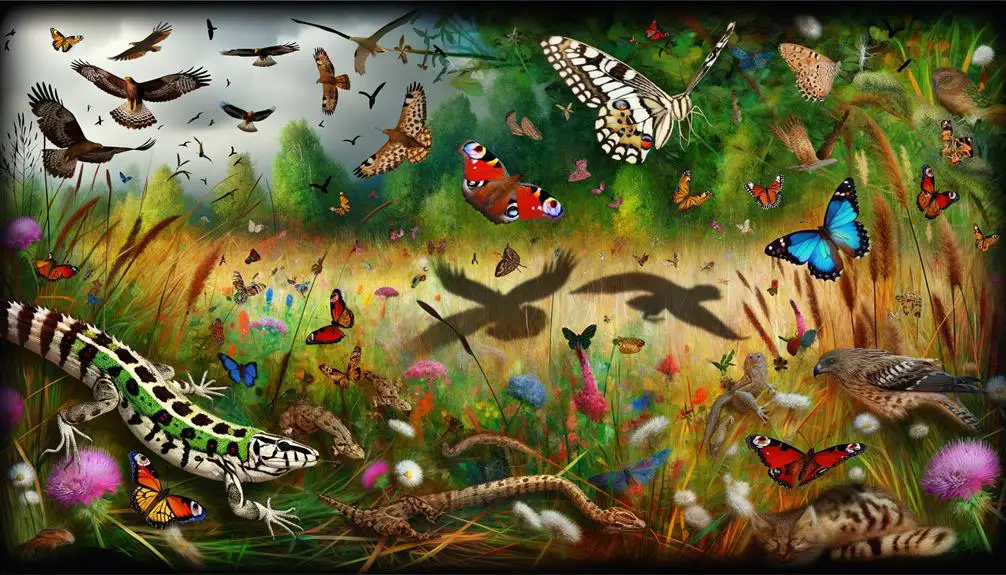
Key Takeaways
- Birds like flycatchers and swallows use keen eyesight and specialized hunting techniques to prey on butterflies.
- Spiders capture butterflies using intricate, high-tensile silk webs and advanced ambush tactics.
- Ants utilize organized hunting strategies and pheromone trails to target butterfly larvae.
- Lizards prey on both larvae and adult butterflies, significantly influencing their population dynamics.
Birds
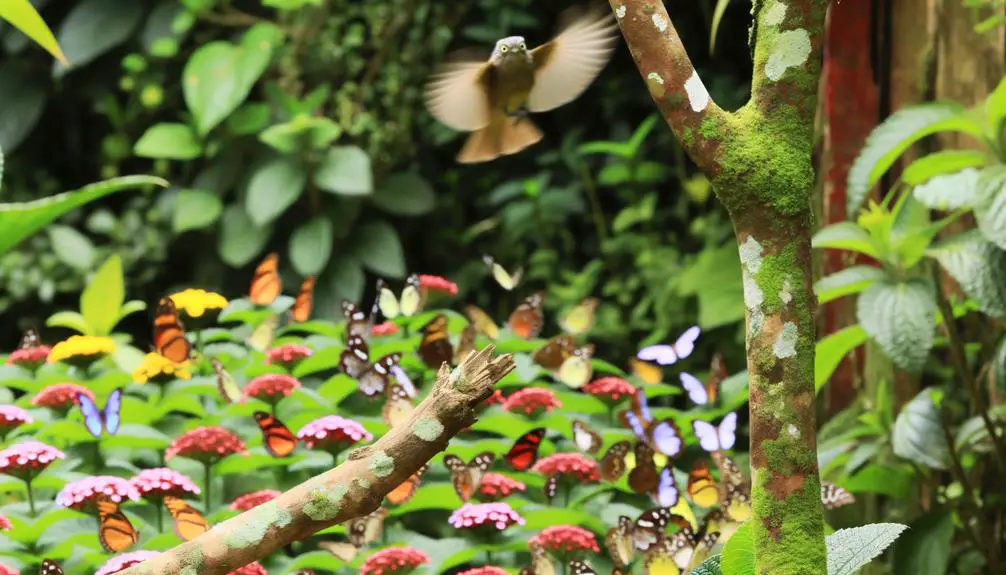
Birds, frequently the most formidable predators of butterflies, utilize their keen eyesight and agile flight to capture these insects with remarkable efficiency.
Avian species such as flycatchers, swallows, and warblers have evolved specialized hunting techniques to exploit the vulnerabilities of butterflies. Their acute vision allows them to detect subtle movements and vibrant colors from considerable distances, while their rapid, precise flight maneuvers enable them to swiftly intercept butterflies mid-air.
Additionally, birds often employ a strategy of selective predation, targeting specific butterfly species that are less toxic or easier to catch.
This predator-prey interaction greatly influences butterfly behavior and morphology, driving adaptations such as cryptic coloration, erratic flight patterns, and the evolution of mimicry to enhance survival in the presence of these adept avian hunters.
Spiders
Spiders, as butterfly predators, employ intricate web traps to ensnare their prey, utilizing silk with high tensile strength and adhesive properties.
Their remarkable camouflage enhances their hunting efficacy, allowing them to remain undetected until the moment of capture.
Additionally, various spider species exhibit advanced hunting skills, such as ambush tactics and precision strikes, further contributing to their success in capturing butterflies.
Web Traps for Butterflies
In the complex web of ecological interactions, spiders utilize intricate web structures to effectively ensnare butterflies, exploiting their aerial mobility for sustenance.
Orb-weaving spiders, in particular, construct geometrically precise webs with a radial symmetry that maximizes the capture area. The silk used is both adhesive and tensile, capable of immobilizing a butterfly upon contact.
The web's strategic placement in flight paths guarantees a higher probability of entrapment. Once ensnared, the spider swiftly administers venom to subdue its prey, preventing escape.
This predatory method highlights the spider's adaptation to capture highly mobile insects such as butterflies. The webs are not static traps but dynamic tools, often rebuilt or repaired to maintain effectiveness in capturing prey, illustrating a sophisticated predatory strategy.
Camouflage and Hunting Skills
Exhibiting remarkable adaptability, some spider species employ sophisticated camouflage and hunting strategies to ambush unsuspecting butterflies efficiently.
Significantly, crab spiders (family Thomisidae) epitomize this predatory behavior. They utilize cryptic coloration to blend seamlessly with flowers, where butterflies often visit for nectar. This mimicry allows crab spiders to remain undetected until their prey is within striking distance.
Upon approach, the spider's rapid, precise movements enable it to capture and immobilize the butterfly with venomous fangs. This ambush strategy is enhanced by the spider's ability to alter its color to match the flower's hue over several days.
Such intricate adaptations exemplify the evolutionary arms race between predator and prey within the ecological niche of butterfly-flower interactions.
Ants
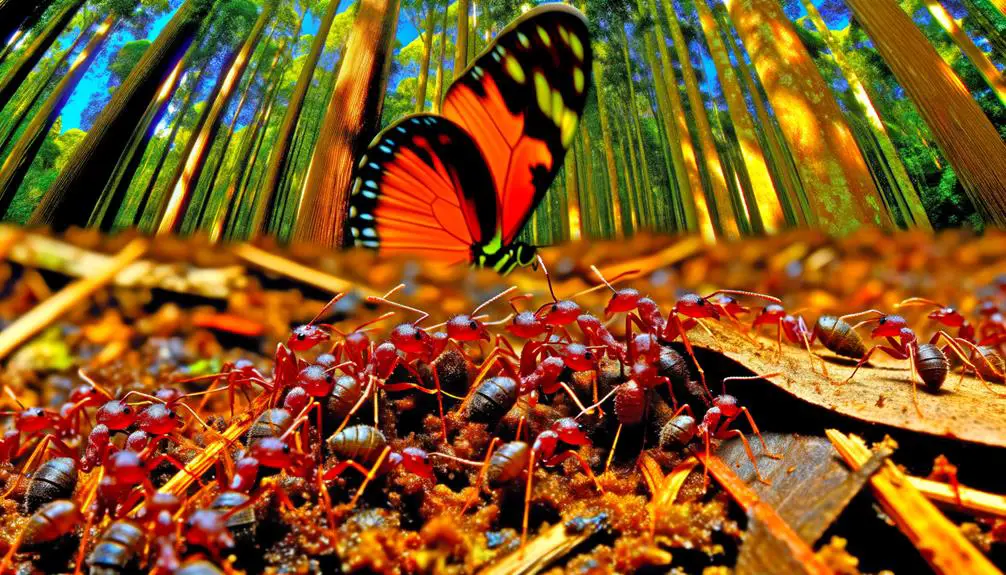
Ants exhibit highly organized hunting strategies that make them effective predators of butterfly larvae.
Caterpillars, particularly in their early developmental stages, are especially susceptible to ant predation due to their limited mobility and defensive capabilities.
Furthermore, ants possess advanced defense mechanisms, such as chemical secretions, which further enhance their predatory efficiency.
Ants' Hunting Strategies
Employing highly coordinated tactics, certain ant species demonstrate remarkable efficiency in preying on butterflies. These ants use sophisticated communication methods, including pheromone trails, to orchestrate collective hunting efforts.
By targeting vulnerable adult butterflies resting or feeding on flowers, ants can immobilize their prey through sheer numbers. Their mandibles deliver precise, debilitating bites, often leading to rapid immobilization.
Additionally, some ants exhibit an ability to exploit the butterfly's attempts to escape by strategically positioning themselves to intercept these movements. This methodical approach guarantees minimal energy expenditure while maximizing predation success.
The ants' cooperative behavior and tactical precision underscore their role as formidable predators within the butterfly's ecosystem, contributing notably to the natural checks and balances of these populations.
Caterpillar Vulnerability to Ants
Caterpillars often demonstrate considerable vulnerability to ant predation due to their relatively slow mobility and limited defensive mechanisms. These larvae lack the speed and agility to evade the swift and organized attacks of ant colonies. Ants can overwhelm caterpillars through sheer numbers, exploiting their inability to escape quickly.
Moreover, caterpillars possess minimal physical defenses; their soft bodies are highly susceptible to ant mandibles. The chemical camouflage some caterpillars employ is ineffective against ant detection, which relies on pheromonal cues.
Additionally, the exposed habitats of caterpillars, such as leaves and stems, make them accessible targets for foraging ants. This predation pressure considerably impacts caterpillar survival rates, influencing butterfly population dynamics and ecological interactions.
Ant Defense Mechanisms
To effectively counteract predation and assure colony survival, various ant species have evolved a suite of sophisticated defense mechanisms.
These include chemical defenses, such as the secretion of formic acid, which can deter or incapacitate predators.
Additionally, ants utilize physical defenses, such as powerful mandibles and stingers, to fend off attackers.
Social cooperation is another critical aspect; ants exhibit highly coordinated behaviors, including alarm signaling and mass recruitment, to collectively confront threats.
Certain species also construct intricate nests with fortified entrances to limit predator access.
These multifaceted strategies not only protect individual ants but also assure the continuity of the colony, highlighting the evolutionary ingenuity of these eusocial insects in predator deterrence.
Wasps
Wasps, particularly parasitoid species, play a notable role in the predation of butterfly larvae, affecting butterfly populations and ecosystem dynamics.
Parasitoid wasps, such as those from the families Ichneumonidae and Braconidae, lay their eggs inside or on the larvae. Upon hatching, the wasp larvae consume the host from within, ultimately leading to its demise.
This form of biological control can greatly impact butterfly population dynamics by reducing larval survival rates.
Additionally, predatory wasps, like those in the Vespidae family, capture and feed on butterfly larvae and adults. This predation plays a crucial role in controlling butterfly populations and maintaining ecological balance. Understanding these interactions can provide insights into food webs and species survival strategies, with the Morpho butterfly diet explained through its reliance on fermenting fruit and tree sap rather than nectar. Despite their striking blue appearance, Morpho butterflies must stay vigilant to avoid becoming prey for these wasps.
These interactions highlight the intricate predator-prey relationships in ecosystems, underscoring the importance of wasps in regulating butterfly populations and maintaining ecological balance.
Lizards
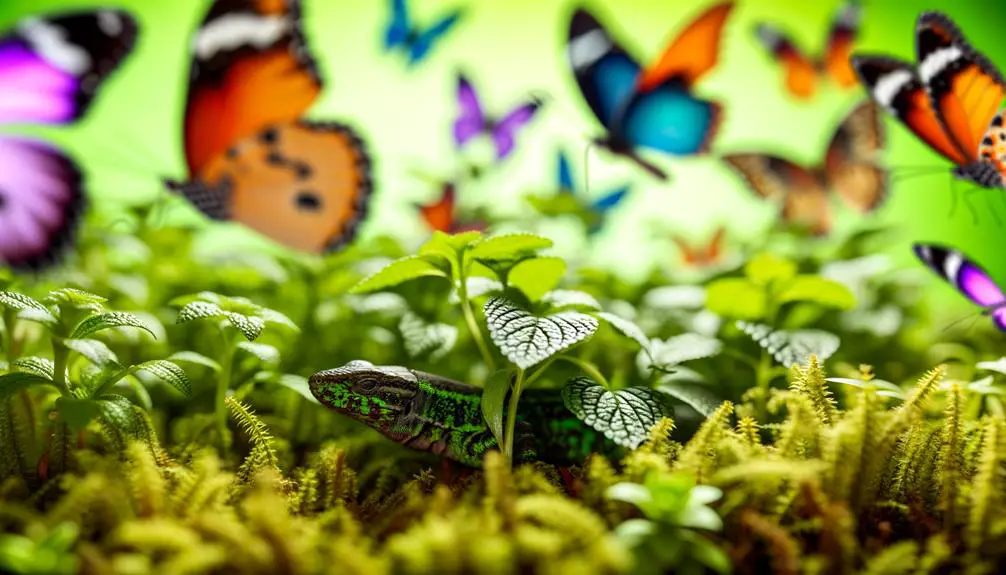
Lizards, as opportunistic predators, greatly influence butterfly populations by preying on both larvae and adult butterflies. These reptiles exhibit a broad range of predatory behaviors that considerably affect butterfly survival rates. Lizards' acute vision and swift reflexes enable them to efficiently capture butterflies, often targeting them during vulnerable stages.
- Rapid decline in butterfly numbers: Lizards can decimate local butterfly populations.
- Disruption of breeding cycles: Predation on larvae hampers reproductive success.
- Loss of biodiversity: Butterfly species diversity is threatened by lizard predation.
Understanding the predation patterns of lizards is essential for conservation efforts aimed at protecting threatened butterfly species from local extinction.
Frogs
In addition to lizards, frogs also play an important role as predators of butterflies, particularly targeting the larval and pupal stages.
Frogs are primarily opportunistic feeders, utilizing their keen vision and rapid tongue reflexes to capture caterpillars and pupae. These amphibians are more active during periods of high humidity, enhancing their hunting efficiency.
The moist environments where frogs thrive often coincide with habitats rich in butterfly larvae, leading to frequent predation events. Furthermore, the varied diet of frogs allows them to exert considerable pressure on local butterfly populations, potentially influencing the distribution and abundance of these insects.
Mammals

Mammals, particularly small carnivorous species like bats and rodents, contribute greatly to the predation of butterflies, primarily targeting adult butterflies and occasionally their larvae.
Bats utilize echolocation to hunt nocturnal butterflies, efficiently capturing them mid-flight. Rodents, on the other hand, often consume butterfly larvae and pupae found in their habitats.
These mammalian predators play a significant role in controlling butterfly populations, influencing their distribution and survival rates.
- Bats' echolocation skills lead to precise predation, creating a nightly peril for butterflies.
- Rodents' foraging habits disturb butterfly larvae and pupae, contributing to early-stage mortality.
- The mammalian impact on butterflies underscores the delicate balance within ecosystems.
Parasitic Insects
While mammals pose significant threats to butterflies, parasitic insects present a more insidious form of predation, targeting various stages of the butterfly's life cycle with remarkable specificity. Parasitic wasps and flies are particularly notorious, deploying their larvae to feed on butterfly eggs, caterpillars, or pupae. These parasitic insects exhibit highly specialized behaviors, aligning their life cycles with that of their hosts. For instance, Tachinid flies lay eggs on caterpillars, and upon hatching, the larvae burrow inside to consume the host from within. Similarly, Braconid wasps inject eggs directly into caterpillars, leading to internal parasitism.
| Parasitic Insect | Target Stage | Method of Parasitism |
|---|---|---|
| Tachinid Flies | Caterpillar | Egg laying on host |
| Braconid Wasps | Caterpillar | Injection of eggs |
| Chalcid Wasps | Pupa | Infestation and consumption |
This parasitism often results in the death of the host, demonstrating the lethal efficiency of these insects.
Conclusion
In a seemingly idyllic world where butterflies epitomize beauty and fragility, a plethora of predators lurks, poised to disrupt their serene existence.
Birds, spiders, ants, wasps, lizards, frogs, mammals, and parasitic insects constitute a diverse array of threats, each employing unique strategies to capture these delicate creatures.
Ironically, the very vibrancy and elegance that make butterflies so enchanting also render them conspicuous targets within their ecosystems.
Consequently, the butterfly's allure simultaneously seals its fate, underscoring the complex dynamics of natural selection.

